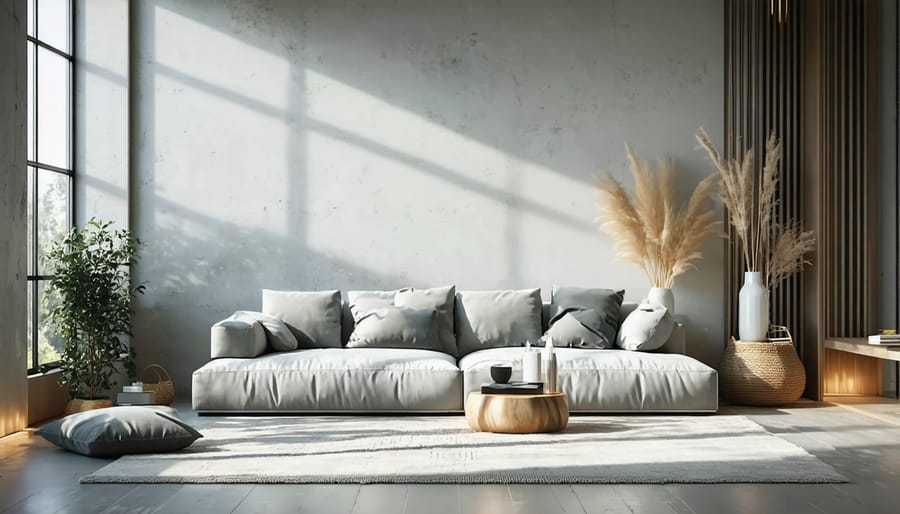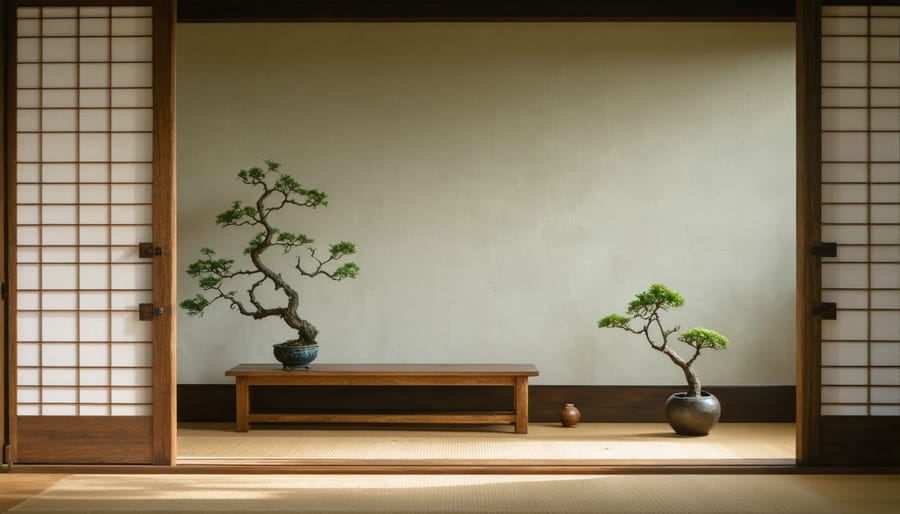Transform your living space into a sanctuary of peace by embracing minimalist home organization ideas rooted in ancient Zen principles. Start by removing one item from each room daily, focusing on objects that don’t serve a clear purpose or bring genuine joy. Create breathing room between furniture pieces, maintaining at least 18 inches of space to allow energy to flow freely through your home. Establish clean, uncluttered surfaces by following the “one in, one out” rule: whenever a new item enters your space, another must leave.
The intersection of minimalism and Zen philosophy isn’t just about decluttering—it’s about crafting intentional spaces that nurture inner peace. Choose neutral colors for walls and furniture, incorporating natural materials like bamboo and cotton to ground your space in organic simplicity. Keep only items that serve either a practical purpose or hold deep personal meaning, displaying them thoughtfully to create visual harmony.
This mindful approach to home organization transcends mere aesthetics, creating an environment where both space and mind can breathe freely. When your physical space reflects clarity and purpose, your mental space naturally follows suit, fostering a deeper sense of calm and contentment in daily life.
The Core Principles of Zen-Inspired Organization

Mindful Space Management
Creating mindful spaces begins with a thoughtful evaluation of each area in your home. Start by observing how you naturally move through and use different spaces throughout your day. Ask yourself: What purpose does this space serve? How does it make me feel when I enter? These simple questions can reveal whether your spaces align with your intentions.
Consider the flow of your daily activities and ensure each area supports rather than hinders your routines. For example, if you find yourself constantly dropping items on a specific counter or table, that might indicate a need for a dedicated landing zone or storage solution in that spot.
When evaluating spaces, use the “pause and assess” technique: stand in the doorway of each room for 30 seconds and notice what draws your attention first. Is it clutter? A peaceful view? Your immediate reaction often highlights areas that need adjustment.
Think about the energy of each space. A zen-inspired room should feel open and welcoming, with clear pathways and purposeful furniture placement. Remove items that don’t serve the room’s primary function or that create visual noise. Remember, empty space isn’t wasted space – it’s an essential element that allows your room to breathe.
Create zones within larger spaces based on activities: a reading nook in the living room, a coffee station in the kitchen, or a meditation corner in the bedroom. This intentional organization helps maintain order and supports mindful living through thoughtful space management.
The One-In-One-Out Rule
The One-In-One-Out Rule is a cornerstone of maintaining a minimalist zen lifestyle, offering a simple yet powerful way to prevent clutter from creeping back into your space. The concept is beautifully straightforward: for every new item you bring into your home, an existing item must leave.
This practice creates a natural pause before making purchases, encouraging mindful consumption. Before buying something new, ask yourself: “What item will this replace?” This simple question helps evaluate whether the new acquisition truly adds value to your life.
The rule works particularly well for categories like clothing, books, and decorative items. For example, when you buy a new sweater, choose an old one to donate. When adding a new plant to your collection, consider gifting one to a friend. This approach maintains the delicate balance of your space while allowing for meaningful updates to your environment.
To implement this rule effectively, keep a donation box in a convenient location. When you bring in something new, immediately select an item to place in the box. This creates a smooth, automated process that becomes second nature over time.
Remember, the goal isn’t to maintain an exact count of possessions but rather to cultivate awareness of what comes into your space. This mindful approach helps preserve the peaceful, uncluttered environment that’s essential to minimalist zen living.
Creating Your Zen Organization System
Decluttering with Purpose
Transforming your space into a zen sanctuary begins with intentional decluttering. Unlike traditional decluttering methods, purposeful minimalism focuses on creating harmony between functionality and simplicity.
Start by dividing your space into zones based on daily activities. For each zone, identify the essential items that genuinely support your lifestyle. Ask yourself: “Does this item serve a clear purpose?” and “Has it been used in the past six months?” These questions help distinguish between necessary belongings and excess.
Create three categories: keep, donate, and remove. Items in the “keep” category should align with your minimalist goals while maintaining practical utility. The “donate” pile should include gently used items that could benefit others. The “remove” category is for items that no longer serve any purpose or are beyond repair.
Remember that decluttering with purpose isn’t about creating an empty space – it’s about crafting room for what truly matters. Keep items that spark joy and serve practical functions, like that well-loved coffee maker or your favorite reading chair. The goal is to achieve balance between aesthetic minimalism and everyday usefulness.
As you progress, focus on one area at a time to avoid feeling overwhelmed. Start with visible spaces like countertops and tables before moving to hidden storage areas. This methodical approach helps maintain momentum while ensuring each space receives proper attention.
Consider implementing the “one in, one out” rule moving forward. When bringing new items home, remove something similar to maintain your newly achieved balance. This sustainable approach prevents future clutter while honoring your commitment to purposeful minimalism.
Smart Storage Solutions
In the spirit of zen minimalism, effective storage is about creating harmony between functionality and visual serenity. The key lies in implementing smart storage solutions that keep belongings organized while maintaining a clean, uncluttered appearance.
Start by adopting the principle of hidden storage. Use furniture pieces that serve dual purposes, such as ottomans with interior compartments or beds with built-in drawers. These elements maintain the room’s peaceful atmosphere while maximizing space efficiency.
Consider implementing the Japanese concept of ‘ma’ (negative space) in your storage design. Rather than filling every available space, leave deliberate gaps between storage units. This creates visual breathing room and prevents the overwhelming feeling that often comes with cramped storage areas.
For closets and wardrobes, invest in quality closet organization systems that emphasize vertical space utilization. Choose modular components in neutral colors that blend seamlessly with your room’s aesthetic. Organize items by category and frequency of use, keeping daily essentials at eye level.
Incorporate natural materials like bamboo or light wood for storage containers and organizers. These materials not only echo zen aesthetics but also add warmth to the space. Use clear containers sparingly and only when necessary to maintain visual calm.
Remember to regularly assess and adjust your storage solutions. The zen approach emphasizes flexibility and adaptation. Every three months, evaluate what’s working and what isn’t, and make mindful adjustments to your storage system. This ongoing process helps maintain the balance between functionality and tranquility that defines minimalist zen living.
Apply the “one in, one out” rule to prevent storage areas from becoming overwhelmed. When adding new items, remove something of similar size or purpose. This practice helps maintain the intentional simplicity of your space while ensuring storage remains efficient and purposeful.

Daily Maintenance Rituals
Creating daily rituals that maintain your minimalist zen space doesn’t have to be complicated. In fact, the simpler your maintenance routine, the more likely you are to stick with it. Here’s a gentle approach to keeping your space peaceful and organized throughout the day.
Start your morning by making your bed immediately after waking up. This small act sets a positive tone and creates an instant sense of order in your bedroom. Follow this with a quick five-minute tidy of your bathroom after your morning routine – wipe down surfaces, hang towels neatly, and return items to their designated spots.
Before leaving any room, practice the “one-minute rule”: if something takes less than a minute to put away or organize, do it immediately. This prevents clutter from accumulating throughout the day. Keep a small basket in each room for collecting items that belong elsewhere, and make it a habit to redistribute these items during natural transitions in your day.
In the evening, spend 10 minutes on a “sunset sweep” – clear kitchen counters, fold throw blankets, and return scattered items to their homes. This ritual ensures you wake up to a fresh, organized space. Additionally, designate a spot near your entrance for keys, mail, and everyday items to prevent them from migrating throughout your home.
Remember to maintain digital zen as well. End each day by clearing your desktop, organizing downloads, and closing unnecessary browser tabs. These small, consistent actions create a foundation of order that supports your minimalist lifestyle and promotes lasting peace in your space.
Designing Peaceful Spaces
Color and Material Selection
Color and material selection plays a vital role in creating a minimalist zen space, setting the foundation for tranquility and peace. Start with a neutral color palette that draws inspiration from nature – think soft whites, warm beiges, gentle grays, and muted earth tones. These colors create a sense of calm while making your space feel more open and breathable.
When selecting your base colors, aim for no more than three main hues throughout your space. White is often the primary choice, as it reflects light and creates a clean canvas. Complement this with natural accents like warm wood tones or stone-inspired grays. Avoid bright or jarring colors that can disrupt the peaceful atmosphere you’re trying to create.
For materials, prioritize natural elements that bring texture and warmth to your space. Bamboo, unfinished wood, natural cotton, and linen are excellent choices that align with zen principles. These materials not only look beautiful but also create a tactile connection to nature, enhancing the calming effect of your environment.
Consider incorporating elements like:
– Untreated wood furniture or flooring
– Natural fiber rugs and textiles
– Stone or concrete accents
– Bamboo window treatments
– Cotton or linen upholstery
Remember that the materials you choose should be sustainable and long-lasting. Quality over quantity is a key principle in minimalist design. Select pieces that will age gracefully and require minimal maintenance, allowing you to create a space that remains serene and beautiful for years to come.
Negative Space Utilization
In the world of minimalist zen design, negative space isn’t just empty area – it’s a powerful tool that creates breathing room for both your space and mind. The Japanese concept of “Ma” teaches us that these intentional voids are just as important as the objects we choose to keep in our homes.
Think of negative space as the canvas that allows your carefully chosen pieces to shine. When you maximize small spaces through thoughtful arrangement, you’re not just decluttering – you’re creating visual harmony that promotes peace and tranquility.
To effectively utilize negative space, start by identifying areas that feel cramped or overwhelming. Remove unnecessary items and create deliberate gaps between furniture and decor pieces. A good rule of thumb is to leave at least 30% of any surface or wall space empty. This principle applies to shelves, tabletops, and even wall arrangements.
Consider the flow of movement through your rooms. Negative space should create natural pathways that guide you through your home without obstruction. When arranging furniture, resist the urge to fill every corner. Instead, allow some areas to remain undefined, creating pockets of calm that give your eyes and mind a place to rest.
Remember that negative space isn’t about creating stark, lifeless rooms. It’s about finding the perfect balance between function and serenity. By embracing empty space, you’re not just designing a room – you’re crafting an atmosphere of peace and mindfulness that truly embodies the minimalist zen philosophy.

Embarking on your minimalist zen journey is more than just decluttering your space – it’s about creating a mindful sanctuary that nurtures both your physical environment and mental well-being. By embracing the principles we’ve explored, you’re taking meaningful steps toward a more balanced, intentional lifestyle.
Remember that transformation doesn’t happen overnight. Start small, perhaps with a single drawer or corner, and allow the positive effects to ripple through your space naturally. The key is consistency and mindfulness in your approach, rather than rushing to achieve instant results.
As you continue your minimalist zen practice, keep these essential takeaways in mind: focus on quality over quantity, maintain regular decluttering habits, and create purposeful spaces that serve your daily needs. Let go of items that don’t bring value to your life, and carefully consider new additions to your space.
Most importantly, make this journey your own. While zen principles provide a wonderful foundation, your interpretation should reflect your personal needs and lifestyle. Don’t feel pressured to create a picture-perfect minimalist space – instead, aim for a harmonious environment that brings you peace and clarity.
Take the first step today, even if it’s as simple as clearing your bedside table or organizing your desk. With each mindful decision and thoughtful adjustment, you’re creating not just a cleaner space, but a more serene and balanced way of living.
